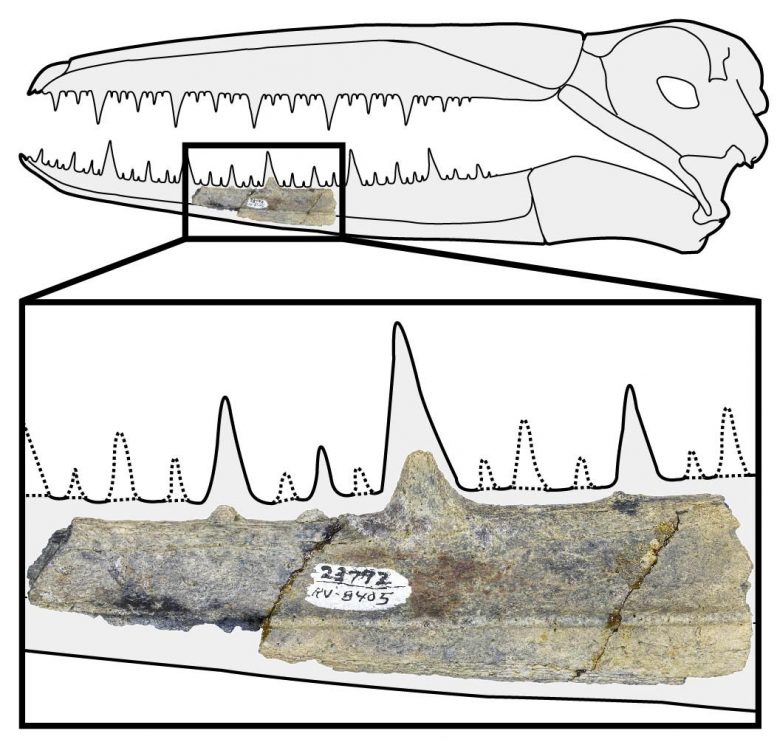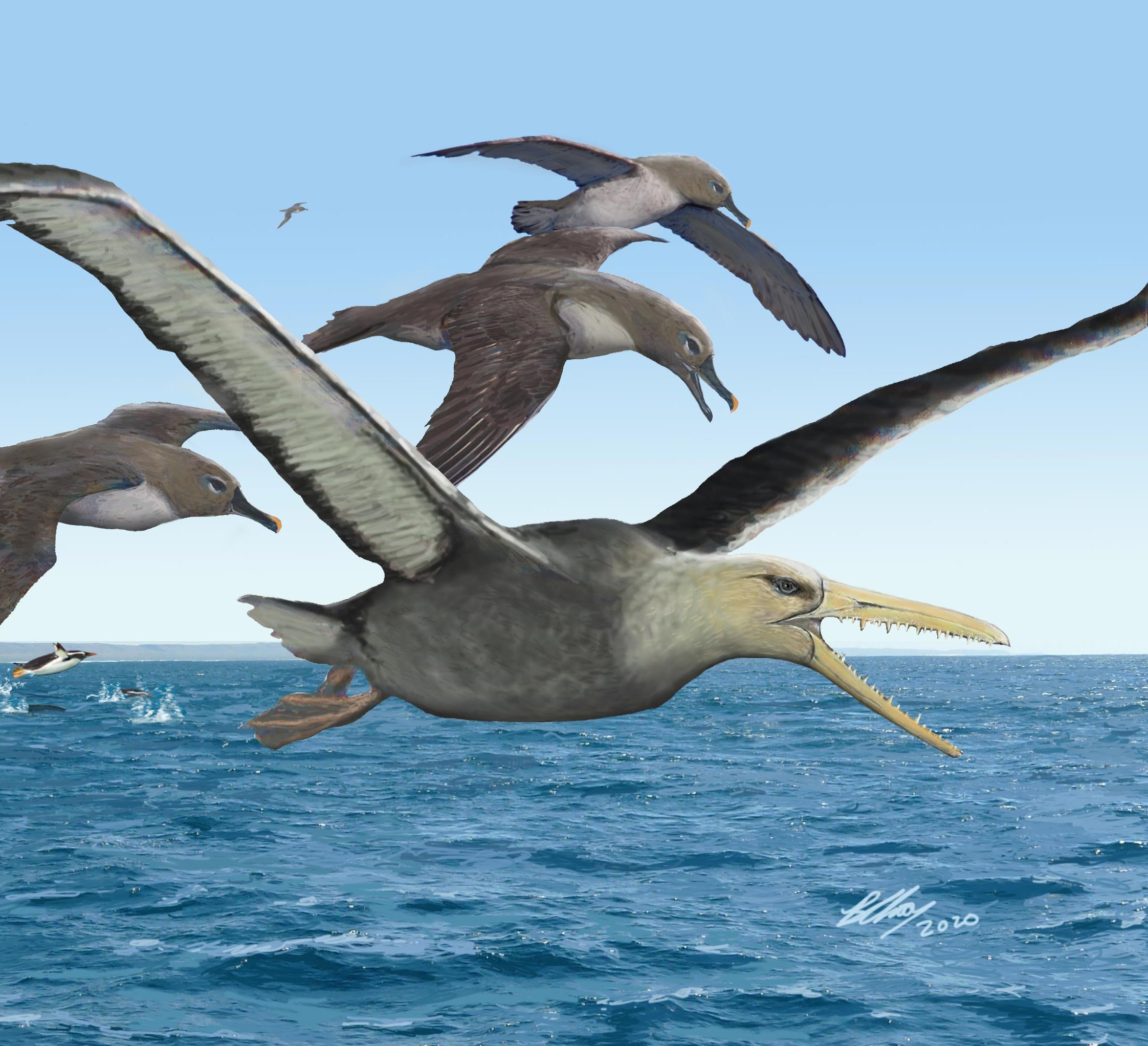An artist’s depiction of ancient albatrosses harassing a pelagornithid – with its fearsome toothed beak – while penguins frolicked in the oceans around Antarctica 50 million years ago. Photo credit: Copyright Brian Choo
Two fossils from a group of extinct seabirds represent the largest individuals ever found.
Fossils recovered from Antarctica in the 1980s represent the oldest giant members of an extinct group of birds that patrolled the southern oceans with a wingspan of up to 21 feet and the wingspan of today’s largest bird, the migratory albatross, in outshone.
The birds, known as pelagornithids, filled a niche very similar to that of today’s albatrosses and traveled far across the oceans of the earth for at least 60 million years. Although a much smaller pelagornithid fossil dated 62 million years ago, one of the newly described fossils – a 50 million year old portion of a bird’s foot – shows that the larger pelagornithid formed immediately after extinction 65 million years ago than their relatives Birds, the dinosaurs, are extinct. A second pelagornithid fossil, part of a jawbone, dates from around 40 million years ago.
“Our fossil discovery, with an estimated span of 5 to 6 meters – nearly 20 feet – shows that after the dinosaurs became extinct, birds grew to truly gigantic sizes relatively quickly and ruled the oceans for millions of years. Said Peter Kloess, a PhD student at the University of California, Berkeley.
The last known pelagornithid dates back to 2.5 million years ago, a time of climate change when the earth cooled and the ice ages began.
Kloess is the lead author of a paper describing the fossil that appears in the open access journal this week Scientific reports. Its co-authors are Ashley Poust of the San Diego Natural History Museum and Thomas Stidham of the Institute of Vertebrate Paleontology and Paleoanthropology at the Chinese Academy of Sciences in Beijing. Both Poust and Stidham received PhDs from UC Berkeley.
Birds with pseudoteeth
Pelagornithids are known as “bony-toothed” birds because of the bony protrusions or struts on their jaws that resemble sharp-edged teeth, although they are not real teeth like those of humans and other mammals. The bony protrusions were covered by a horny material, keratin, which resembles our fingernails. The struts, called pseudoteeth, helped the birds catch octopuses and fish from the sea while floating perhaps for weeks over much of the earth’s oceans.

This 5-inch segment of fossilized jaw, discovered in Antarctica in the 1980s, dates back to 40 million years ago. The bird’s skull would have been about two feet long, while the pseudoteeth, originally covered in horny keratin, would have been up to an inch long. On this scale, the bird’s wingspan would have been 5 to 6 meters, or about 20 feet. Photo credit: UC Berkeley Image by Peter Kloess
Large flying animals have periodically appeared on Earth, starting with the pterosaurs, which fluttered their leathery wings and reached wingspans of 33 feet during the dinosaur era. The pelagornithids came to reach the wingspan of the Cenozoic era after the mass extinction and lived until about 2.5 million years ago. At about the same time, now extinct teratorns ruled the sky.
The birds related to vultures “developed wing spans close to what we see in these bony-toothed birds (pelagornithids),” said Poust. “In terms of time, teratorns are second with their huge size, having evolved 40 million years after the life of these pelagornithids. The extreme, huge size of these extinct birds is unmatched in ocean habitats. ”
The fossils the paleontologists describe are among the many collected from Seymour Island off the northernmost tip of the Antarctic Peninsula in the mid-1980s by teams led by paleontologists from UC Riverside. These finds were then brought to the UC Museum of Paleontology at UC Berkeley.
Kloess stumbled across the specimens when browsing the collections as a newly arrived doctoral student in 2015. He had completed his Masters at Cal State-Fullerton 17 to 5 million years ago with a thesis on Miocene territorial seabirds based on specimens found in museum collections, including those at the UCMP.
“I love going into collections and only finding treasure there,” he said. “Somebody called me a museum rat, and I’ll take that as a badge of honor. I love rushing around and finding things that people overlook. ”
Kloess checked the original notes from former UC Riverside student Judd Case, who is now a professor at Eastern Washington University near Spokane, and found that the fossil foot bone – called a tarsometatarsus – came from a geological formation older than originally thought . That meant the fossil was about 50 million years old instead of 40 million years old. It is the largest known specimen for the entire extinct group of pelagornithids.
The other rediscovered fossil, the middle part of the lower jaw, has received parts of its pseudoteeth; They would have been up to 3 cm tall when the bird was still alive. The approximately 12 cm long, preserved jaw section came from a very large skull that would have been up to 60 cm long. By measuring the size and spacing of these teeth and making analytical comparisons with other pelagornithid fossils, the authors show that this fragment came from a single bird as large, if not larger, than the largest known skeletons of the osseous teeth group of birds.
A warm Antarctic was a bird playground
Fifty million years ago, Antarctica had a much warmer climate during the Eocene and wasn’t the forbidden, icy continent we know today, noted Stidham. In addition to extinct land mammals such as marsupials and distant relatives of sloths and anteaters, a wide variety of Antarctic birds occupied land, sea, and air.
The southern oceans were the playground for early penguin species, as well as extinct relatives of living ducks, ostriches, petrels, and other groups of birds, many of which lived on the islands of the Antarctic Peninsula. The new research shows that these extinct, predatory, large and giant bony-toothed birds were part of the Antarctic ecosystem for over 10 million years, flying side by side over the heads of swimming penguins.
“In a lifestyle likely resembling living albatrosses, the extinct giant pelagornithids with their very long-tipped wings would have flown far over the ancient open seas in search of cuttlefish and fish that have not yet been dominated by whales and seals and other seafood that one could with their beaks lined with sharp pseudoteeths, ”said Stidham. “The big ones are almost twice the size of albatrosses, and these bony-toothed birds would have been formidable predators that have become frontrunners in their ecosystem.”
Museum collections like that of the UCMP and the people like Kloess, Poust and Stidham who dismantle them are key to reconstructing these ancient habitats.
“Collections are hugely important, so discoveries like this pelagornithid would not have been possible if we hadn’t had these specimens in public trust, be it at UC Riverside or now in Berkeley,” said Kloess. “The fact that they exist for researchers to look at and study is of incredible value.”
Reference: “Earliest fossils of giant bony-toothed birds (Aves: Pelagornithidae) from the Eocene of Seymour Island in Antarctica” by Peter A. Kloess, Ashley W. Poust and Thomas A. Stidham, October 26, 2020, Scientific reports.
DOI: 10.1038 / s41598-020-75248-6



